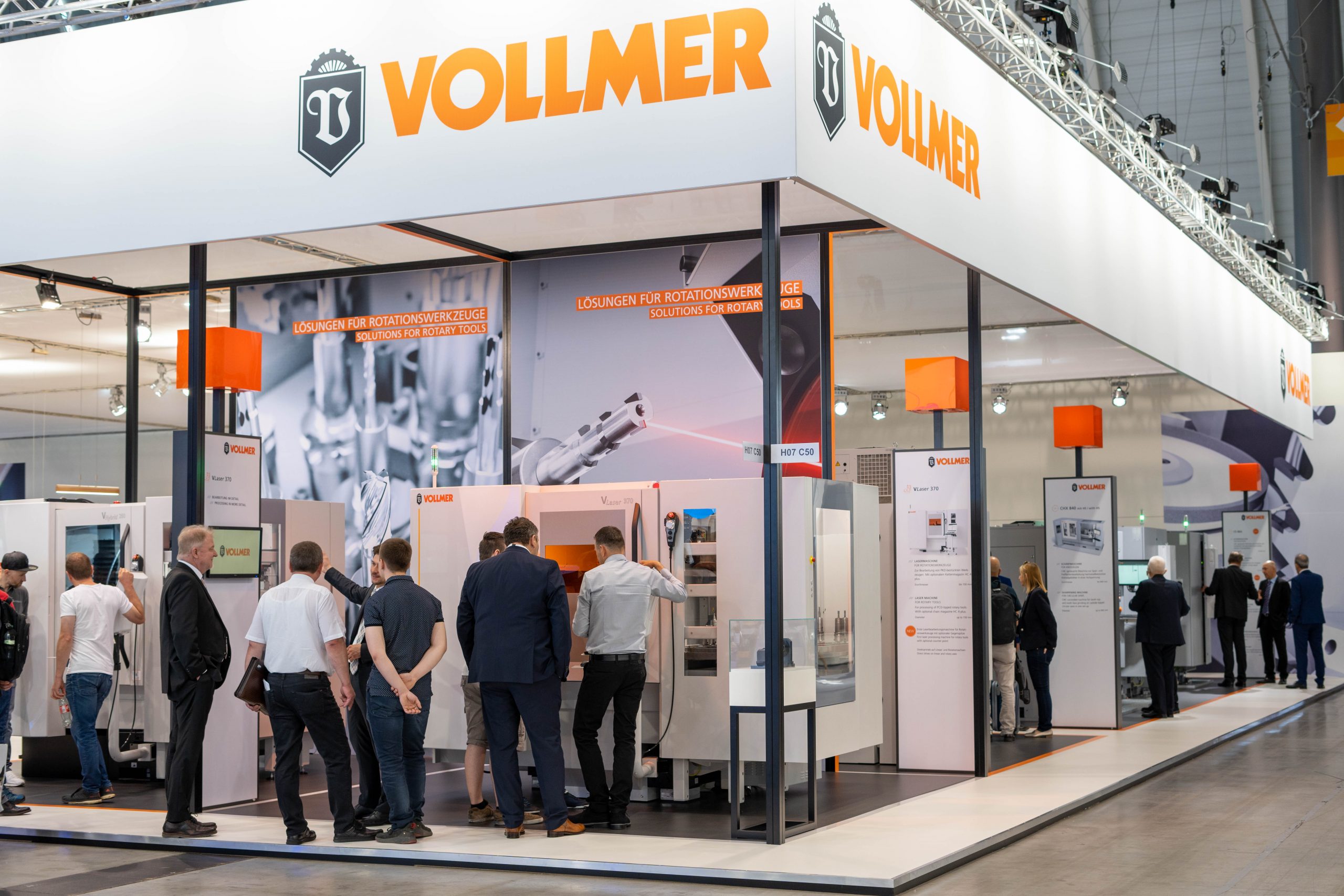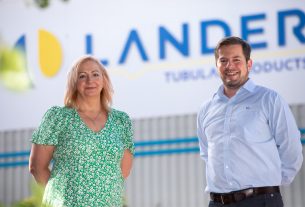Becoming a ‘full line’ solution provider is little more than a distant dream or aspiration that many machine tool builders will never achieve. With the arrival of the new VLaser, VOLLMER has achieved this ambitious feat that is the envy of its rivals.
With grinding, disc and wire erosion already in its portfolio for processing rotary cutting tools, the one remaining step for the Biberach manufacturer was to develop a laser machining solution. At the GrindingHub exhibition, the R&D experts and product managers from VOLLMER proudly presented the next step in the company’s evolution – the VLaser 370. As a Project Engineer for the VLaser, Christopher Lang introduces this exciting innovation.
Providing an overview of the new VLaser, Christopher says: “The VLaser 370 has been in development for about the last 5 years. With a new machine concept and patented kinematics, we ensure that the VOLLMER laser machine enables reliable and highly accurate machining of customers’ tools. It allows the machining of tools with a diameter up to 150mm and a length of up to 250mm (from HSK 0). In addition to that, the machine is the first in the market to have an optional counterpoint, which enables the highest concentricity by machining between centres.”
“To make the laser process as simple as possible for our customers, we have implemented the already well-known intuitive VBS100 user interface and a programming system known from the VPulse. I am convinced that with the VLaser, we have excelled with our entry into the field of laser processing of tools and I am very proud to be part of it.”
Was there a gap in the VOLLMER portfolio that the VLaser has filled?
“We undertook a full line promotional campaign in 2020, as we now have three different processes at VOLLMER: the eroding, grinding and now the laser. The laser process closes the gap in the market and gives us the possibility to offer our customers the exact solution they need for the production of their tools. In some instances, there are operations that only the laser can do, such as edge preparation and chip breakers – this is what we additionally are providing with the VLaser. Eroding technology cannot process chip breakers and this is a technology we wanted to provide our customers.”
“Through further developments in laser technology, it is also possible to meet the increasing requirements in tool production. It will allow customers to define the cutting edge, so they can decide whether the tool is to be used for wood, metal or composite processing.”
“There’s a technology overlap between the VLaser and the existing VPulse, but this is part of having a full line of solutions – giving the customer a choice. Depending on the tool portfolio of the customer, they can decide whether, for example, the VPulse and EDM technology, the VHybrid with a combination of grinding and EDM technology or the VLaser with the option of laser cutting of chip breakers is the right choice of machine. With the VLaser, it is possible to machine a wide variety of materials beyond PCD, such as CBN, CVD-D and MCD. This is the advantage of having a full product line, we can provide the ‘best-fit’ solution.”
Building the machine concept
Developing a new machine concept can be a daunting task. For VOLLMER, its 110 years of machine building expertise and an existing full line of proven technology provided a fundamental bedrock to create, evolve and deliver the VLaser concept. As Christopher says: “The basic concept was that we could set the focus point of the laser on the pivot point of one rotary axis of the machine to achieve less compensating movements during machining – but this was not completely new. We have already created this philosophy on other machines like the VGrind where this concept has worked well. We wanted to transfer this advantage to a laser machine too.”
“The construction design and orientation of the axes are new, but we must focus on the key advantage. This is the fixed beam path and the focus point set in the pivot point of one rotary axis. With the increasing demands upon tool manufacturers and their tools, the patented kinematics used here enables us to achieve a high level of accuracy even with more complex tool contours. This is due to fewer compensating movements, it also means fewer possible deviations while maintaining the same efficiency,” says Christopher confidently.
Not to completely skip the construction of the new VLaser; the fundamental concept of the machine is built upon an extremely stable and rigid polymer concrete base and all axes are sat upon the vertical Z-axis. The machine can process tools up to 150mm in diameter and up to 250mm in length. The X, Y and Z-axis linear motors and cooling deliver unparalleled precision and repeatability. Likewise, the tool rotating A-axis and the C-axis also incorporate glass scales, torque motors and temperature-controlled cooling.
Working ‘contact-free,’ these features eliminate wear and achieve higher axis speeds and acceleration rates. The unique kinematics that focuses all axes’ movement on the C-axis pivot point limits compensating movements and further enhances precision and repeatability. “Additionally, we can also process cutting tools between centres. This is another advantage of this machine. It enables us to achieve an even better radial run out on the tools.”
The Laser
With the introduction of any new technology, customers will always have a sense of trepidation. Addressing this, Christopher adds: “VOLLMER has been working on a laser machine for quite some time. Therefore, the technology is not entirely new and unknown. With the know-how and experience from the other technology segments at VOLLMER, we were able to combine the already known advantages of our machine construction with laser technology in this machine concept. The resulting laser machine is the ideal addition to our existing portfolio.”
From a stability perspective, Christopher adds: “Compared to other laser machines on the market, we aimed for the solution of having no movement in the beam path. This was solved by firmly connecting the laser source and the beam guidance housing to the central block that is made of polymer concrete. This means that there are no negative influences from machine movements or vibrations that could cause the focal point of the laser beam to deviate from its fixed position in the pivot point.”
Different, but the same
Like any innovation, existing customers will be cautious of the control and operating concept of a new machine. However, as part of VOLLMER’s over-arching strategy to create synergy between machine types, the new VOLLMER VLaser 370 utilises the same VBS100 operating system as the existing VPulse 500 and VHybrid 360 machines.
Referring to this, Christopher comments: “Looking at the machine from the operator perspective, we have a very easy-to-use VBS100 HMI interface that is also common with the VHybrid and VPulse machines. This VOLLMER software is where we can set the workplan, create programs, identify the position of tools in the tool changer and even choose the correct standard parameters from the technology data management system.”
“In addition to the user interface, there is also the programming system. Here, we use EXPROG Laser, which is also used on the VPulse. Existing EXPROG programmes can be downloaded directly into the machine, even from other machines with different technology like the VPulse. One of our core beliefs is the machine has to be easy to operate, so the operator can select what type of cutting conditions they need. We make this easy because we have our ‘technology data management’ system that allows the customer to select the right technology for their tool.. In addition, technology data management will in future allow the operator to choose between different types of materials to be cut, such as CBN, MCD or CVD.”
For manufacturers that don’t already have a VPulse or VHybrid and are unfamiliar with the VBS100 operating system, the user-friendly interface is clear and intuitive with the choice of touch screen or conventional operation. It also has flexible intervention options; integrated parameter management and it defines the job processing sequence to create absolute simplicity for the operator. Like all new VOLLMER technology, it incorporates IoT technology with remote on-machine support.
Working in cooperation with the VBS100 operating system is the EXPROG Laser software. It has a short learning curve and quickly enables operators to programme everything from simple end mills to complex step tools. EXPROG also has a DXF interface for reading external tool contours. Furthermore, it allows users to freely define the shape and size of clearance angles for each contour element of the tool – providing complete design freedom. It also provides automatic measurement of the axial and radial position of the tool tips.
Efficiency keeps getting better
With the worldwide escalation in energy costs and environmental sustainability being on the lips of engineers on every continent, Christopher addresses the operational costs of the VLaser: “The energy consumption of the laser machine will be less than other machines. This is because the VLaser will only require compressed air and electrical current. When we talk about efficiency in terms of tool production, it depends on many factors that have to be taken into account. For example, we have to consider the contour length, plate thickness, the number of clearance angles and also the surface finish and quality levels required. These are all factors that can impact both the speed of processing and the operational costs.”
Automation
A key element in the efficiency chain is automation and the ability of the machine to operate unmanned. Here, VOLLMER has integrated the very latest HC4 Plus automation system. Highlighting the evolution from the HC4 to the HC4 Plus, Christopher says: “This new automation system is based on the HC4. The HC4 Plus is a little bigger and this allows us to handle the complete tool range up to 150mm in diameter. On the HC4 Plus, a major advantage is that the customer can choose whether they want to work with all the same types of tools or differing types and diameters.”
The new HC4 Plus can accommodate 160 tools up to 15mm diameter, 80 tools up to 40mm diameter, 40 tools up to 80mm diameter and an impressive 20 tools from 120 to 150mm diameter. In comparison, the existing HC4 chain magazine system can accommodate 39 HSK63 tools with diameters up to 70mm with a capacity for 158 shank-type tools. Not only can the HC4 Plus far exceed the capacity of large tools compared to its HC4 predecessor, but it can also support tools up to 10kg whereas the HC4 can hold tools to a maximum weight of 5kg.
The next step
As laser technology progresses for VOLLMER, Christopher is filled with excitement for the journey ahead, concluding: “Step by step, we will continually improve our processes and improve the surface finishes, efficiency and features of the machine. The precision level is already at a very high level. Unlike other processes, laser cuts through diamond grains without mechanical forces, generating a much sharper and more precise edge than ever before.”
“Laser machining is at the start of a very long road. The eroding process is always somewhat limited because of the electrical conductivity. The laser machine is therefore also an addition for processing non-conductive materials. So, in the future, we expect the VLaser to take big steps forward in its technological evolution. We have no interest in replacing the VPulse with this machine. Our goal is to complement existing technologies and machines and give the customer the biggest range of options available to find the ‘best-fit’ technology for their business.”





